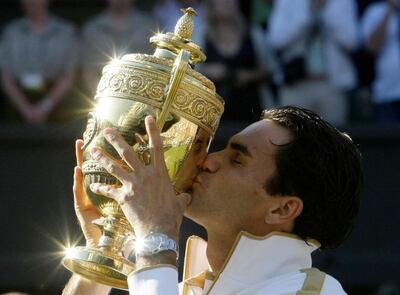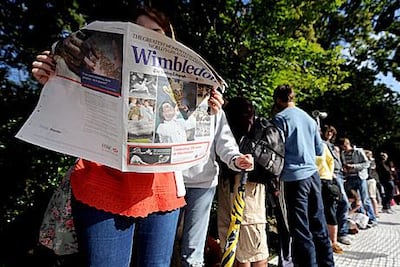Roger Federer is “devastated”. Ashleigh Barty is shattered. Serena Williams is – as she chose to phrase it – “shooked”.
The cancellation of this year's Wimbledon – for the first time since the Second World War – has, understandably, hit the tennis community hard.
It was a decision everyone saw coming, but that didn’t stop the sporting world from flooding our Twitter timelines with broken heart emojis and tearful GIFs.
The tennis season came to a screeching halt a little over three weeks ago when the Indian Wells tournament was cancelled the night before qualifying was due to start. All tours have been suspended since, and on Wednesday, we learned there won't be any tennis until at least July 13.
If so many tennis tournaments had already been cancelled, why was Wimbledon’s announcement met with such emotional reaction?
“Because it’s WIMBLEDON,” tweeted Croatian world No 24 Donna Vekic.
That’s a simple, yet apt, way of putting it.
Wimbledon means so many things to so many people. In a sport that has an 11-month season packed with tournaments, Wimbledon stands out as the pinnacle, and Centre Court is tennis’ Mecca.
Federer loves it so much that he won it eight times. Novak Djokovic, who is regarded as a master of the hard courts, dreamt of triumphing on the grass courts of the All England Club since he could remember, and built little Wimbledon trophies in his bedroom, pretending he had won it. He's won it in real life on five occasions.
Wimbledon is where the late Jana Novotna cried on the shoulder of the Duchess of Kent after she lost the 1993 final to Steffi Graf. She would become champion on that very same court five years later. It’s where Croatian wildcard Goran Ivanisevic claimed his only Grand Slam by defeating Pat Rafter on ‘People’s Monday’.
It's where fans gathered on Henman Hill for years, championing their home favourites until Andy Murray ended Britain's 77-year drought at the tournament by lifting the trophy in 2013.

Wimbledon strikes an almost impossible balance between keeping its historic and traditional feel, while still embracing the modern age. Its two main show courts have state-of-the-art retractable roofs yet can still transport you to an era gone by.
Centre Court is where royals, celebrities and dignitaries make regular appearances in the Royal Box, but it’s also where die-hard fans from the famous Wimbledon Queue, are given access to the best seats in the house.
No other tournament has thousands of people camp out in tents each night, a week before the event even starts. No other tournament takes 'Middle Sunday' off. No other tournament sees the champion and runner-up take a lap of honour together. The Royal Box dress code is so strict, that Formula One champion Lewis Hamilton was once refused entry for not abiding by it.
The first time I went to Wimbledon was in 2009. I chose the perfect day to go as a fan, on ‘Manic Monday’, where all fourth round matches of both the men’s and women’s events are staged – another feature unique to the Championships.
Full disclosure: Wimbledon was never really my favourite tournament. I preferred the slower surfaces that featured longer rallies, and didn’t enjoy the ace-fests that were very prominent on the speedy grass courts of the late 90’s.
But that all changed the second I set foot inside the All England Club 11 years ago. The venue is like a time machine that takes you back. The atmosphere feels whimsical; you cannot really put a finger on it. Maybe it’s the tennis whites on the immaculate green grass, or maybe it’s the beautiful stadiums and courts, covered in flowers and lush with historic memories.
In her autobiography, Maria Sharapova described Wimbledon’s members’ locker room – dedicated to the seeded players during the Championships – as “the most beautiful locker room in the world”.
In 2009, I watched Juan Carlos Ferrero defeat Gilles Simon on Court No 3 before I made my way to Court No 1, where Andy Roddick ousted Tomas Berdych. Here’s another great thing about Wimbledon – if you queue on Henman Hill, you can buy a £5 (Dh23) ticket that was resold for charity, given by fans who chose to leave the venue early. That’s how I got into Court No 1.

I returned to the Championships in 2014 as a reporter, and haven’t missed a Wimbledon since. For three weeks each summer over the past six years, I was lucky enough to call the All England Club my office. So did hundreds of other reporters, players, coaches, organisers, and staff.
The week before Wimbledon starts is the most magical tennis experience of all. The grounds are still closed to the public, and the players and their entourages, along with the press, are the only ones onsite.
I’d pick up a bowl of Wimbledon’s signature strawberries (sans cream in my case) from the media café and walk over to Aorangi Park, which is home to the most picturesque practice courts in tennis. Ask any tennis journalist and they tell you that watching a player during practice is a therapeutic experience. There is comfort in the repetition of groundstrokes, and music in the sound of the ball coming off of a freshly-strung racquet. Add to that the stunning Aorangi Park landscape and you feel like you’re in tennis paradise.
The tennis tour can get monotonous as you hit the same cities and stadiums on the same week every year, but I’m not the only one who would say that visiting Wimbledon never gets old. You feel privileged just being there; which is why missing out on another year of Wimbledon is a tough pill to swallow.
In the grander scheme of things, tennis is far from being the most important thing right now. We all acknowledge that. But I also understand why the players are heartbroken over the tournament’s cancellation.
Many are aware that their time on that hallowed Wimbledon turf is limited. None more than Federer and Williams perhaps, whose best chances of adding to their Grand Slam tally is undoubtedly at Wimbledon. They will both be 39 years old when next year’s edition comes around.
“This could have a direct impact on our history books forever,” Roddick said of Wimbledon’s cancellation on the Tennis Channel on Wednesday.
It already has. For the first time in 75 years, Wimbledon will not take place.









